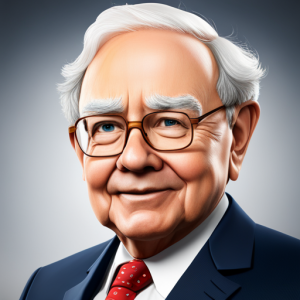Peter Lynch: The Legendary Investor’s Strategies and Successes

Peter Lynch is a well-known American investor, mutual fund manager, and philanthropist. He is best known for his work as the manager of the Magellan Fund at Fidelity Investments between 1977 and 1990. During this time, Lynch achieved an average annual return of 29.2%, consistently more than double the S&P 500 stock market index. This made the Magellan Fund the best-performing mutual fund in the world.
Lynch is considered one of the most successful and well-known investors of all time. He is renowned for his investment philosophy that emphasizes the importance of investing in companies that you understand and that have strong growth potential. Lynch is also known for his ability to identify undervalued stocks and for his focus on long-term investing. His investment strategies have been studied and emulated by investors around the world.
Despite his success, Lynch has not been immune to mistakes. In recent years, he has expressed regret over not investing in certain companies, including Apple. Lynch has also been critical of the Securities and Exchange Commission (SEC) and its approach to regulating the financial industry. Overall, however, Lynch’s contributions to the world of finance have been significant, and his investment strategies continue to be studied and admired by investors around the world.
Early Life and Education
Peter Lynch was born on January 19, 1944, in Newton, Massachusetts. When he was seven years old, Lynch’s father was diagnosed with cancer. Three years later, Lynch’s father passed away, and his mother had to work to support the family. Lynch reports that from his early teens, he worked as a caddie to help support the family.
Lynch attended Boston College, where he studied history, philosophy, and psychology. After graduating in 1965, he worked as a teller at Fidelity Investments while studying for his MBA at the Wharton School of the University of Pennsylvania. Lynch earned his MBA in 1968 and returned to Fidelity Investments, where he worked as a research analyst.
Lynch’s interest in finance began at a young age. As a child, he would read the stock tables in the newspaper and ask his father about the companies listed. His interest in the stock market continued throughout his education, and he began investing in stocks while still in college.
During his time at Fidelity Investments, Lynch gained a reputation as a skilled analyst and stock picker. He was promoted to the role of portfolio manager in 1977 and went on to manage the Fidelity Magellan Fund from 1977 to 1990. Under Lynch’s leadership, the Magellan Fund grew from $18 million to $14 billion in assets and became one of the most successful mutual funds in history.
Overall, Lynch’s early life and education set the stage for his successful career in finance. His interest in the stock market from a young age, combined with his education at Boston College and Wharton, gave him the knowledge and skills he needed to succeed in the world of finance.
Career at Fidelity
Peter Lynch’s career at Fidelity Investments is one of the most storied in the history of finance. During his time at Fidelity, Lynch managed the Magellan Fund, which became the largest mutual fund in the world under his leadership. This section will explore Lynch’s career at Fidelity, including his time managing the Magellan Fund, his investment style, and the assets under management during his tenure.
Magellan Fund
Lynch became the manager of the Magellan Fund in 1977, when it had only $20 million in assets under management. By the time he retired in 1990, the fund had grown to over $14 billion in assets. Under Lynch’s leadership, the Magellan Fund became the best-performing mutual fund in the world, with an annualized return of 29.2%. This was more than double the return of the S&P 500 over the same period.
Managing the Portfolio
Lynch’s investment style was focused on finding undervalued companies that had strong growth potential. He was known for his ability to spot trends early and invest in companies that were poised for growth. He was also a believer in doing extensive research and due diligence on the companies he invested in, often visiting their facilities and meeting with management teams.
Lynch was also known for his ability to communicate his investment ideas to retail investors. He wrote several books, including “One Up On Wall Street” and “Beating the Street,” which became best-sellers and helped to popularize value investing among individual investors.
Investment Style
Lynch’s investment style was focused on finding companies that had strong growth potential but were undervalued by the market. He believed that the best way to find these companies was to do extensive research and due diligence, including visiting company facilities and meeting with management teams.
Lynch was also a long-term investor, holding stocks for several years or even decades. He believed that short-term market fluctuations were often driven by emotion rather than fundamentals, and that patient investors could take advantage of these fluctuations to buy stocks at attractive prices.
Overall, Lynch’s investment style was focused on finding companies that had strong growth potential but were trading at a discount to their intrinsic value. He was a believer in doing extensive research and due diligence, and was known for his ability to communicate his investment ideas to retail investors.
In conclusion, Lynch’s career at Fidelity was marked by his success managing the Magellan Fund and his innovative investment style. He was a pioneer in value investing and his ideas continue to influence investors today.
Investment Strategy
Peter Lynch is a renowned investor who managed the Fidelity Magellan mutual fund from 1977 to 1990. His investment strategy is based on the principle of investing in what you know. He believes that individual investors have an advantage over Wall Street and large money managers because they can spot investment opportunities in their daily lives.
Invest in What You Know
According to Peter Lynch, investors should focus on investing in companies that they understand. They should look for companies whose products or services they use, or whose business models they are familiar with. This approach can help investors identify undervalued companies that have strong long-term growth prospects.
PEG Ratio
Peter Lynch also recommends using the PEG ratio to evaluate stocks. The PEG ratio is calculated by dividing a company’s price-to-earnings (P/E) ratio by its earnings growth rate. A PEG ratio of less than 1 is considered undervalued. This ratio takes into account a company’s earnings growth rate, which can help investors identify companies that are growing faster than their peers.
Homework
Peter Lynch emphasizes the importance of doing your homework before investing in a company. Investors should thoroughly research a company’s financial statements, management team, and industry trends before making an investment decision. This can help investors identify risks and opportunities that may not be immediately apparent.
Business Model
Peter Lynch also suggests that investors should focus on a company’s business model. A strong business model can help a company generate sustainable profits and grow over the long term. Investors should look for companies with a competitive advantage, a strong brand, and a clear growth strategy.
Forecast
Finally, Peter Lynch recommends that investors should avoid trying to predict short-term market movements. Instead, investors should focus on identifying companies with strong long-term growth prospects. By investing in companies with a solid business model, a competitive advantage, and a clear growth strategy, investors can benefit from long-term capital appreciation.
Overall, Peter Lynch’s investment strategy emphasizes the importance of investing in what you know, doing your homework, and focusing on a company’s business model and long-term growth prospects. By following these principles, investors can identify undervalued companies with strong long-term growth potential.
Investment Books
Peter Lynch is widely considered one of the most successful investors of all time, and his books have become classics in the field of investing. His investment philosophy is grounded in the belief that individual investors can beat professional investors by doing their own research and investing in companies that they understand. In this section, we will take a look at some of his most popular investment books.
One Up on Wall Street
One Up On Wall Street is perhaps Peter Lynch’s most famous book. In this book, Lynch shares his investment strategies and insights, and he explains how individual investors can use their knowledge of everyday life to find great investment opportunities. One of the key concepts in the book is the idea that investors can find great companies by observing the world around them and looking for products and services that they use and enjoy.
Beating the Street
Beating the Street is another classic investment book by Peter Lynch. In this book, Lynch shares his experiences as the manager of the Fidelity Magellan Fund, which he grew from $18 million to $14 billion over a 13-year period. He explains how he found great investment opportunities by doing his own research and by investing in companies that he understood. The book also includes many real-world examples of Lynch’s investment successes and failures.
Learn to Earn
Learn to Earn is a beginner’s guide to investing, co-authored by Peter Lynch and John Rothchild. In this book, Lynch explains the basics of investing in a way that is easy to understand, and he provides readers with the tools they need to start investing on their own. The book covers a wide range of topics, including the stock market, mutual funds, bonds, and more. It also includes many real-world examples to help readers understand the concepts presented.
Overall, Peter Lynch’s investment books are must-reads for anyone interested in investing. His investment philosophy is grounded in common sense, and his books provide readers with the tools they need to become successful investors. Whether you’re a beginner or an experienced investor, there’s something to learn from Peter Lynch’s investment books.
Philanthropy
Peter Lynch is not only known for his successful career as an investor and mutual fund manager but also for his philanthropic endeavors. He is a known supporter of education and has been involved with the Catholic Schools Foundation for over three decades.
The Lynch Foundation
Founded in 1988, The Lynch Foundation is a non-profit organization that supports education, healthcare, and cultural programs in the Greater Boston area. The foundation was established by Peter Lynch and his wife, Carolyn, with the aim of funding ideas that are responsive to local needs.
One of the primary focuses of The Lynch Foundation is education. The foundation has been a significant supporter of the Catholic Schools Foundation, which provides scholarships to families in need to send their children to Catholic schools in Massachusetts. The Lynch Foundation has also established the Peter Lynch Scholar program, which honors Peter’s involvement with the Catholic Schools Foundation and Inner-City Scholarship Fund.
Aside from education, The Lynch Foundation also supports healthcare and cultural programs. The foundation has provided funding for medical research and treatment programs, as well as for cultural institutions such as the Boston Children’s Museum and the Museum of Fine Arts, Boston.
The Lynch Foundation has been committed to funding bold ideas that are responsive to local needs. The foundation has provided grants to a wide range of organizations, from small community groups to large institutions. The foundation’s grants have supported initiatives such as early childhood education, mental health programs, and affordable housing.
In conclusion, Peter Lynch’s philanthropic endeavors have made a significant impact on the Greater Boston area. The Lynch Foundation’s support for education, healthcare, and cultural programs has helped to improve the lives of many individuals and communities.
Conclusion
Peter Lynch’s life and investment strategies have revolutionized the finance and investment world. He showed that successful investing isn’t just for the pros – it’s within reach of anyone armed with knowledge and good old-fashioned common sense. Lynch had an uncanny ability to spot promising companies and invest in them before they became household names.
Lynch’s investment philosophy was centered around investing in companies that he understood and that had a competitive advantage. He believed in doing thorough research, including visiting the company’s facilities and talking to its management team before investing. Lynch also believed in diversification, and he advised investors to spread their investments across different sectors and industries.
While Lynch’s investment strategies were successful, it’s important to note that the stock market is unpredictable, and corrections can happen at any time. Investors should always be prepared for economic downturns and have a plan in place to manage their investments during tough times.
Furthermore, it’s important to understand the role of debt in investing. While debt can be a useful tool for companies to finance growth, too much debt can be a red flag. Lynch advised investors to pay close attention to a company’s debt levels and to avoid companies with high debt-to-equity ratios.
In conclusion, Peter Lynch’s investment strategies were based on common sense and thorough research. While his strategies were successful, investors should always be prepared for market corrections and should pay close attention to a company’s debt levels. By following Lynch’s investment philosophy, investors can increase their chances of success in the stock market.












